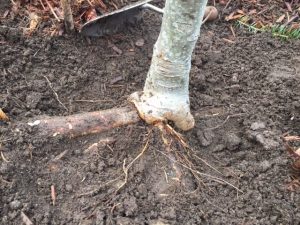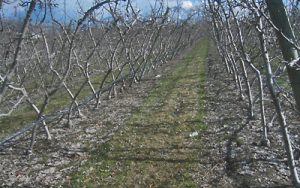“What the heck is a rootstock? ” It is not uncommon for us to hear this from our customers buying fruit trees. Deciding which rootstock to use is one of the complexities of planting fruit trees.
In simple terms, fruit trees are produced by joining the wood of a variety of fruit, like Honeycrisp apple, to a certain rootstock. This grafting a variety of fruit onto rootstock influences how that plant will grow. For fruit trees, various root stocks determine:
- Soil tolerance- tolerant of wet soil? tolerant of drought?
- Vigor (size) of tree- mini-dwarf, dwarf or semi-dwarf
- Anchorage- whether the tree will be self supporting
- Precociousness- how soon the tree will begin fruiting
- For some root stocks, disease and pest resistance
For most people living on small city lots, full size fruit trees are not a good option. Full size (also known as ‘standard’) fruit trees make take 10 years or more to come into bearing, and require large ladders to manage. Dwarfing rootstocks allows closer planting of smaller trees in small spaces. The larger semi-dwarf fruit trees can be planted 10′-15′ apart, and be kept under 15′-20′ with pruning. Some of the more dwarfing root stocks can be planted as close as 4′ apart, and be kept under 8′- no ladders required!
Dwarf rootstocks usually come into full fruit bearing sooner than larger trees. They are often more soil sensitive, needing well-drained soils, and are sometimes less tolerant of winter wet soils. They are also a little less summer drought tolerant than larger rootstock trees. And most dwarf rootstock will need support as they can bear more fruit than their root system can support.
When planting a grafted fruit tree, it is important to plant the graft well above the soil line. If the graft is buried, the variety above the graft may root into the soil. This is called scion rooting. The tree will then become a full sized fruit tree!
Commercial orchardists have been using dwarfing rootstocks for years, as they measure their production in pounds/tonnage per acre rather than pounds per tree. Drive through a commercial orchard area in Wenatchee or Yakima region, and you rarely see apples grown as free standing trees. These trellised orchards are more expensive for the grower to plant, but more than make up the cost in savings in labor- fewer trips up and down ladders. In some commercial orchards that are on flat ground, mobile platforms on trailers replace the ladders of yesteryear.
For the home owner, supporting dwarf trees is usually less elaborate than the elaborate trellis systems used by commercial growers. A stout stake 6″-8″ away from the trunk can support dwarf trees, and can be used as a training tool. This central stake can be used to help train the tree, and can be used with string to support fruit load on the branches. Simple trellis systems can also be used, and some trees can be trained into ornamental shapes in a method called espalier.
Dwarf rootstocks do have some disadvantages compared to semi-dwarf root stocks. The larger root stocks do tolerate a wider range of soil types, and are slightly more drought tolerant in dry summers. Larger rootstocks are usually a year or two later coming into bearing. And these larger trees are more difficult to maintain (pruning, spraying, thinning, harvesting), if allowed to grow to their potential size. Of course, the orchardist does not need to let their trees reach their potential “full size” if they are unafraid and skilled at pruning. Larger rootstocks can have their own advantages beyond soil and drought tolerance. Many people who have deer pressure in their areas will plant larger growing trees. They protect them in early years, but as the trees mature, their lower branches can take some browsing without killing the trees.
Another possible advantage of larger rootstocks is that potential disease infections can be outgrown by the greater vigor. This seems especially true of some marginal stone fruits such as peaches and apricots.
So, before planting fruit trees, ask yourself these questions?
- How big do I want my fruit trees to get?
- What are the best rootstocks for my soil?
- Will I need to support my fruit trees? And how am I going to do that?
- Will I need to water? Do I need drought tolerance?
Answering these questions can help you choose the best rootstocks for your site.




What is scion rooted tree please explain
Scion rooting is when the varietal part of the tree above the graft is in contact with the soil or buried so it forms roots. The tree then loses the properties of the rootstock and will grow to be a full sized tree.
I have a very old variety of a King apple tree, and gravenstein. They are getting old and I am wanting to graft some cuttings to see if I can carry on the genes. What type rootstock would I need to get?
Any apple rootstock will work. We will have M-26 and M-106 available starting in early March, and I will make them available for preorder at the end of this month. With those 2 varieties, the smaller M-26 is more precocious so the new trees will come into fruit sooner. On larger rootstocks, King and Gravenstein can take up to 7 years to come into bearing.